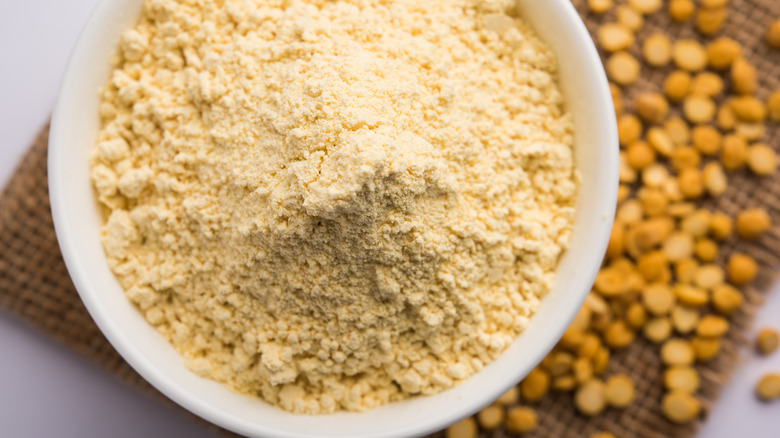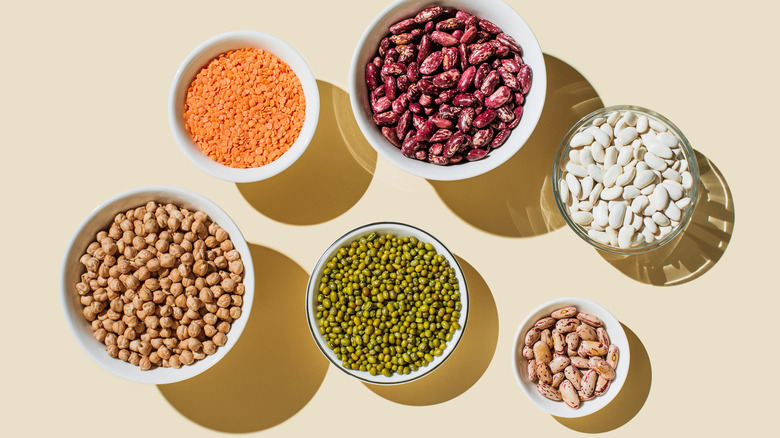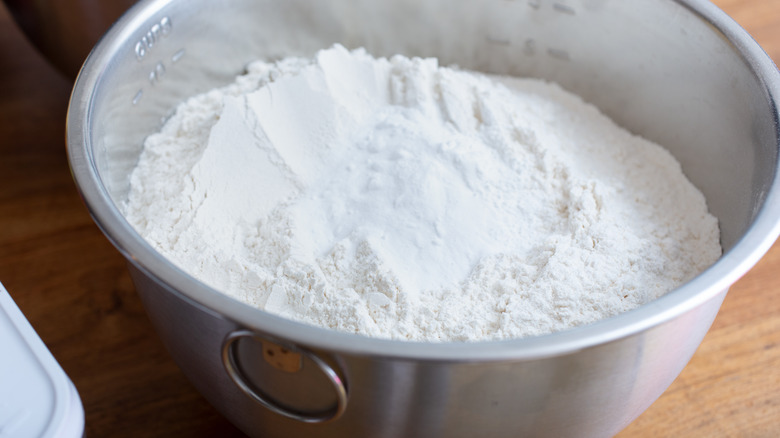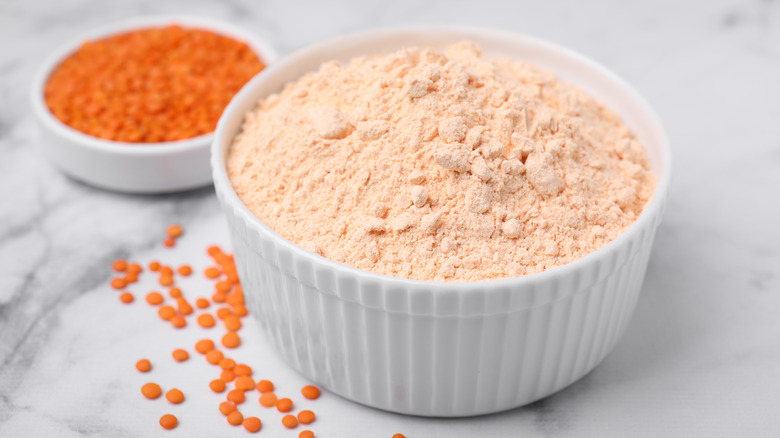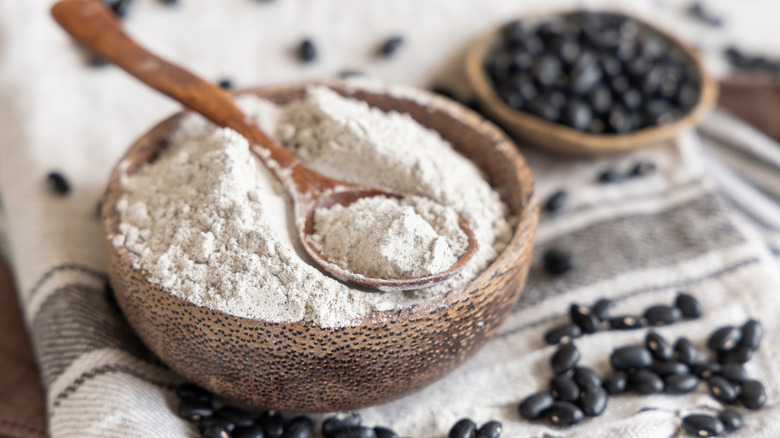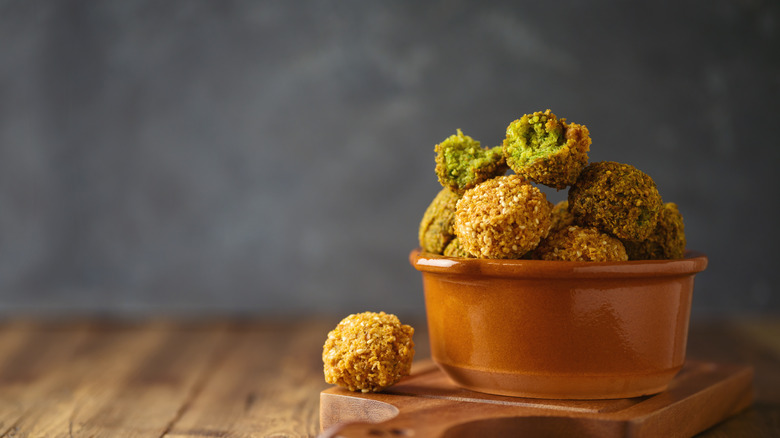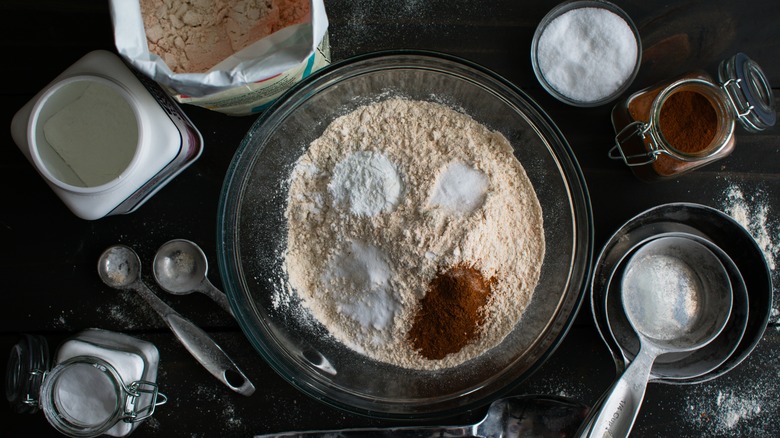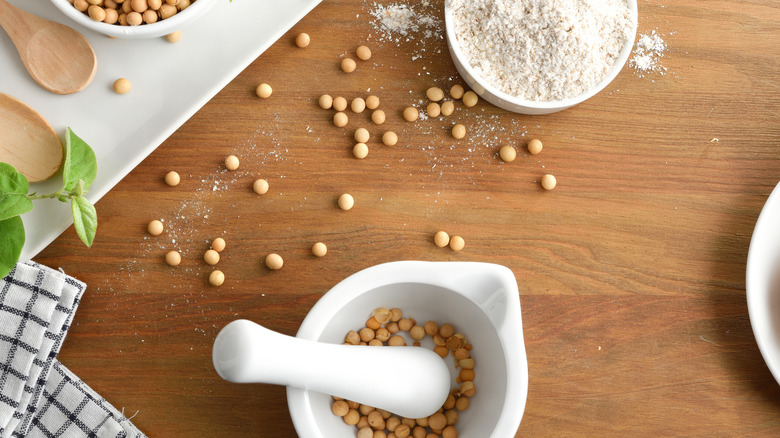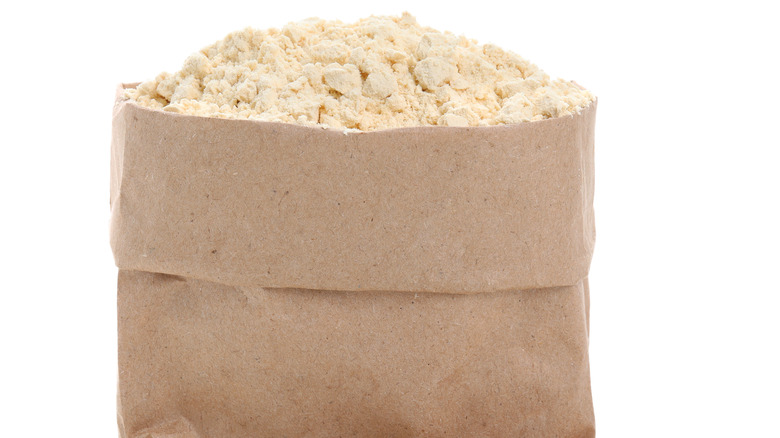What Is Bean Flour And How Do You Use It?
While flour has been a staple in cooking for thousands of years dating back to the Upper Paleolithic in Europe, there are constantly new products being developed in the grain department. You may have noticed that there are nutrient-rich, naturally gluten-free options that are rising in popularity, and you may be wondering, what is bean flour and is it actually made of beans?
"Bean flour is finely ground up and sifted legumes such as chickpeas, soybeans, black beans, and pinto beans. It is a similar process to milling grains. Essentially any legume can be ground up into a fine powder and called bean flour," said Olivia Roszkowski, chef-instructor of Plant-Based Culinary Arts at the Institute of Culinary Education's New York City campus. "But since the legume is uncooked during this process, certain legumes (such as fava beans) can impart a more bitter flavor profile when utilized in recipes."
"The taste of bean flour is distinct and can influence the flavor profile of your recipes, adding earthy or nutty notes depending on the type of beans used," said Jessica Randhawa, owner and head chef of The Forked Spoon. We spoke to nutritionists, registered dietitians, and professional chefs to get the lowdown on bean flour's nutritional content and how you can use it as a replacement in your daily cooking.
What are bean flour varieties?
Bean flour is a general term used for any flour made with ground-up, dried beans. "Some popular ones include: chickpea (garbanzo) flour, black bean flour, soybean flour, fava bean flour, and lentil flour," said Chef Mareya Ibrahim of The Fit Foodie. "Each type brings something different to the table in terms of taste and nutrition. They're all great for boosting the protein and fiber content in your dishes."
Other bean flour options that may be less common to use in recipes are pinto bean flour, navy bean flour, mung bean flour and pea flour. However, when making your bean flour selection, you will want to consider some key facts about each type, as well as what flavor profiles match your dish. For example, fava bean flour is popular in Mediterranean and Middle Eastern cooking, according to nutritionist and Candida Diet author Lisa Richards.
"Chickpea flour, also known as besan or gram flour, is rich in protein and fiber, making it popular in Indian and Middle Eastern cuisines," said Jessica Randhawa. Besan or gram flour is made from split brown chickpeas or chana dal (the skins are removed, making it less bitter than other types of chickpea flour), and garbanzo or chickpea flour is made from white chickpeas. The latter will need a good amount of moisture when you cook with it. If you're looking for a place to start with chickpea flour, try our recipe for papadum.
Bean Flour vs All-Purpose Flour
While bean flour and all-purpose flour may be interchangeable in some recipes, there are some distinct differences to be aware of that may change your mind about which flour you reach for.
The main difference between all-purpose flour and bean flour are the ingredients they are made with. All-purpose flour is made from refined wheat grains, while bean flour can be made from ground, dried beans like chickpeas. With the change in ingredients comes a different nutritional value between the two. Bean flour comes out on top in the nutrient department. "Chickpea flour is notably higher in protein and fiber compared to all-purpose flour. It contains essential nutrients like folate, iron, phosphorus, and magnesium," said Lisa Richards. "This makes chickpea flour a suitable option for those seeking more protein and fiber in their diet, especially for vegetarians and vegans."
All-purpose flour may be missing some of those key nutrients that bean flour contains. However, all-purpose flour often is enriched with iron and B vitamins to replace some of the nutrients lost during processing, according to Richards. Bean flours like chickpea flour are also typically denser than all-purpose flour, making it a better binder while baking. "Plus, they're gluten-free, which is perfect for anyone with gluten intolerance or celiac disease," said Mareya Ibrahim. Finding replacement ingredients for flour in recipes can be a difficult task, particularly for those with gluten sensitivities who have to eliminate flour products.
Bean flour has many health benefits
While bean flour can be created from different kinds of beans, the health benefits are generally all the same. Our experts agree that bean flours first and foremost pack a mean protein punch. "Bean flours are rich in protein, which is essential for muscle repair and growth, as well as overall body function," said Lisa Richards.
High fiber content is another big bonus of bean flour, which can have a positive impact on your overall health and help with weight loss. "Fiber-rich foods like bean flour enhance satiety, aiding in weight management by helping people feel fuller for longer periods. Incorporating bean flour into the diet can significantly improve digestive, metabolic, and cardiovascular health. Fiber also plays a crucial role in blood sugar regulation, slowing the absorption of sugar and preventing spikes in blood glucose levels, which is particularly beneficial for managing diabetes," said Trista Best, a Registered Dietitian at Balance One Supplements and adjunct Nutrition professor. "Additionally, the fiber in bean flour contributes to heart health by lowering cholesterol levels and reducing the risk of cardiovascular diseases."
The fiber in bean flour may also help keep your bowel movements regular and prevent constipation, according to Best, as it serves as a prebiotic and fosters a necessary bacteria growth in your gut microbiome. "[Bean flours] carry complex sugars called oligosaccharides, which are believed to be beneficial to the microbiome," Roszkowski said.
The vitamins and minerals in bean flour is plentiful
Aside from the high protein and fiber level, bean flour can be even more nutritious depending on the way it is prepared. "Beans can also be sprouted, dehydrated, and then milled into flour, which can unlock further nutrients, especially vitamin B, which is often touted for increasing energy levels," said Olivia Roszkowski. "Sprouting can also decrease levels of anti-nutrients such as phytic acid, which can inhibit mineral absorption during the digestion process."
Many bean flours also have low glycemic index (GI), which means they release glucose into the bloodstream more slowly and help to maintain stable blood sugar levels, according to Lisa Richards. The vitamins and minerals in bean flours are plentiful, too, including folate, vitamin B6, iron, magnesium, and zinc — all key in maintaining your overall health and wellness.
Depending on your bean selection, you may find additional benefits. The high fiber, low-carbohydrate and calorie content of chickpea flour makes it a healthier option than all-purpose flour. "Some bean varieties, like black beans and chickpeas, contain antioxidants that help protect cells from damage caused by free radicals," said Lisa Richards. The taste will be different than all-purpose, so be careful not to use a heavy hand with bean powder.
What does bean flour taste like?
Regular all-purpose flour isn't known for having a specific taste. So you may be wondering, if bean flour is made from different beans, do they embody the same flavor as the beans? The answer is yes and no, depending on the type of beans and how you plan to use the flour. "I love using bean flour in my cooking and baking because it adds a rich, nutty flavor and a boost of nutrition," said Jessica Randhawa. "The taste of bean flour is distinct and can influence the flavor profile of your recipes, adding earthy or nutty notes depending on the type of beans used."
Mareya Ibrahim provided some examples of how bean flour tastes can differ between beans. "Chickpea flour gives a subtle nutty taste, while black bean flour brings that bold, earthy punch. It's perfect for savory dishes or mixed with other flours when baking to level up your flavors," she said. "White bean or cannellini bean flour is probably the most mild and neutral in flavor and can even be used in sweets and desserts."
And don't be alarmed if you are taste-testing your bean flour before cooking. In some cases, your bean flour may have a different taste when raw. For example, chickpea flour can have a bitter taste when it is raw, but it becomes much more mild and pleasant when cooked. You won't know how flavors change and meld together until you try it out for yourself!
Bean flour in savory dishes
While the taste of bean flour may be a reason to use caution when baking, it can be an asset for savory dishes. Middle Eastern and Indian cuisines lend themselves to letting bean flour's natural taste shine. "Some well-known foods that commonly use bean flour include chickpea flour-based dishes like socca, a savory flatbread from the south of France, and falafel, a popular Middle Eastern street food," said Jessica Randhawa. "Additionally, Indian cuisine features dishes such as besan (chickpea flour) pancakes and pakoras (vegetable fritters), which rely on the unique properties of bean flour for their distinctive taste and consistency."
The texture of bean flour can also help it act as a gluten-free base, binding or thickening agent while imparting more flavor to your dish. "It's great for adding some oomph to soups, sauces, and gravies," said Mareya Ibrahim. You want to consider the type of bean flour you are using in your savory dishes. Chickpea flour can act as a binder in veggie burgers, while black bean flour may be an asset to Mexican or Southwestern dishes like tortillas or chili, according to Lisa Richards.
You can also use bean flour as a creamy base for dips or fillings. White bean flour is mild enough to be added to a filling for a dairy-free option like lasagna, or as the base of a white cream sauce. Some have found that white bean flour can be a substitute for heavy cream in soups and stews.
Substituting bean flour in baking
The next time you get a craving for your favorite treat, try bean flour. Not only will it make your dessert gluten-free, but it can also increase the protein and fiber. However, our experts warn that the texture may be different when using bean flour. "Mix it up with rice or tapioca flour for that familiar texture," said Mareya Ibrahim.
Lisa Richards noted that lentil flour's sweet taste may make it a good fit for cookies or muffins. Jessica Randhawa said, "Black bean flour has a rich, earthy flavor and is high in antioxidants and iron, ideal for making gluten-free brownies and other baked goods. Lentil flour offers a mild, nutty flavor and is packed with proteins and nutrients, suitable for breads and even in meat dishes as a binder."
Experts also recommend not fully swapping out bean flour for all-purpose flour in a one-to-one ratio. "For baking bread or pastries, swap in up to 25% bean flour with your wheat flour to keep things fluffy and tasty," Ibrahim said. Randhawa echoed using caution due to the density of bean flour, opting to mix bean flour with other flour or natural additives to improve the texture. "Bean flours also absorb liquid differently, so you may need to adjust the amount of liquid in the recipe or add extra moisture to achieve the desired consistency," Richards said. You will also need to add more cooking time and bake at a lower temperature, according to Olivia Roszkowski.
How to make your own bean flour
If you are inspired to make your own bean flour, it is totally doable (and more cost-effective than buying it at the store). Our experts weighed in on the process with some tips and tricks to ensure you are successful with your bean flour-making process.
The first step in your preparation after selecting your bean of choice is to rinse and soak your beans. The length of soaking time can be anywhere from a few hours to overnight, but you do want to ensure the beans soften. "Once soaked, drain and thoroughly dry them," said Mareya Ibrahim. "Next, lightly roast the beans in the oven to get rid of any extra moisture and to boost the flavor." The roasting step enhances the beans' flavor, while also making it easier to finely grind your beans, according to Jessica Randhawa. However, if you're short on time, there is also a technique that skips the roasting step. Lisa Richards opts for draining the beans and drying them on a baking sheet or dehydrator.
Then it is time to grind! Use a high-speed blender, food processor, or grain mill to grind up your beans into a fine powder. Ibrahim recommends sifting the flour to remove any larger bits or particles in your bean flour. Once you've finished the grinding process, you officially have bean flour! Be sure to store your bean flour in an airtight container if you don't plan to use it right away.
Shelf life of bean flour
Our experts say bean flour can last for at least six months if stored properly. "The shelf life of bean flour can vary depending on the type of beans used and how finely it is ground," said Lisa Richards. "Generally, properly stored bean flour can last from six months to one year. Some varieties, like chickpea flour, may last longer due to their lower moisture content."
Some keys to proper storage include an airtight container, which can include a glass jar or plastic container with a tight-fitting lid. You want that tight seal to keep out moisture. Best practice also includes keeping your container in a cool, dry place away from direct sunlight or heat sources (like your pantry). "Just keep an eye out for funky smells or any weird color or texture changes to be safe," said Mareya Ibrahim.
Olivia Roszkowski said the high protein level can affect bean flour's shelf life. "Bean flour is high in protein and is an unrefined product, which can cause it to become rancid at a quicker pace than regular all-purpose flour," she said, also noting that the baked goods made with bean flour will have a shorter shelf-life, too.
There are options if you want to keep your bean flour longer. "For longer storage, bean flour can be kept in the refrigerator or freezer, where it can remain good for up to two years, helping to preserve its flavor and nutritional quality," said Jessica Randhawa.
Where to buy bean flour
If you've fallen in love with bean flour but just don't have the time to make your own, there is nothing wrong with store-bought options. There are many out there, but Mareya Ibrahim recommends trying brands like Bob's Red Mill, Anthony's Goods, and Arrowhead Mills for store-bought bean flour.
The good news is it shouldn't take too long to find some bean flour options. You can likely find bean flour varieties at many health food stores, specialty markets, or even a larger grocery store's health food or gluten-free section. If you aren't able to find bean flour at your local grocery store, some other ideas are to check with vendors at farmer's markets for freshly milled bean flour or at ethnic grocery stores. "Stores that specialize in Middle Eastern, Indian, or Asian foods often carry chickpea flour (gram flour) and other bean flours used in traditional cuisines," said Lisa Richards.
Olivia Roszkowski said you may have more luck finding soybean flour at an Asian food market, while specialty flours like lentil flour can be at Indian markets. If you have scoured the aisles and have still come up empty-handed, there are plenty of options available online. The perk here is that you can buy bean flour in bulk and it may end up being even cheaper. "Shopping online can provide access to a wider variety of bean flours, often at competitive prices," said Jessica Randhawa.
Static Media owns and operates Mashed and Tasting Table.
